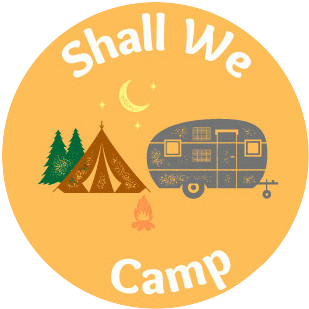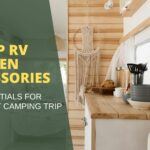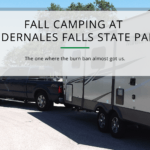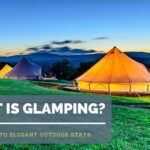Texas summers don’t play around, but that doesn’t mean you have to hide indoors. With the right campground, you can spend your days floating cold rivers, dipping into spring-fed pools, and retreating to shady sites when the sun hits its stride. This guide rounds up eight of our favorite “cool-down” campgrounds across the Lone Star State… from Hill Country swimming holes to Pineywoods lakes… so you can actually enjoy July and August outside.
In Texas, the best A/C is a spring-fed swimming hole under a canopy of cypress.
When I say “beat the heat,” I’m looking for two things: legit water access and real shade. That means rivers you can swim or float, lakes with designated beach areas, and camp loops tucked under oaks, cypress, or pines.
I also factor in how easy it is to get from your campsite to the water (because lugging tubes a mile uphill is not the vibe), plus practical perks like on-site rentals, day-use capacity, and family-friendly entries for waders.
Before you dive in (literally), a couple of quick tips: book day-use and campsites early for weekends, pack water shoes for rocky entries, and check park alerts after big rains as river levels and bacteria advisories can temporarily close swim areas.
Affiliate Disclaimer: This site contains affiliate links, which means I may earn a commission on purchases made through these links at no extra cost to you.
Table of Contents
Why it beats the heat: The Frio River lives up to its name (“frio” = cold). You’ll find long, lazy stretches for floating and plenty of bald-cypress shade along the banks. Campsites and cabins put you close to the water.
The Frio stays refreshingly cool and runs for 2.9 miles through the park. Between swims, you’ve got short hikes (including Old Baldy), paddling, and even the park’s beloved summer dance tradition at the pavilion.
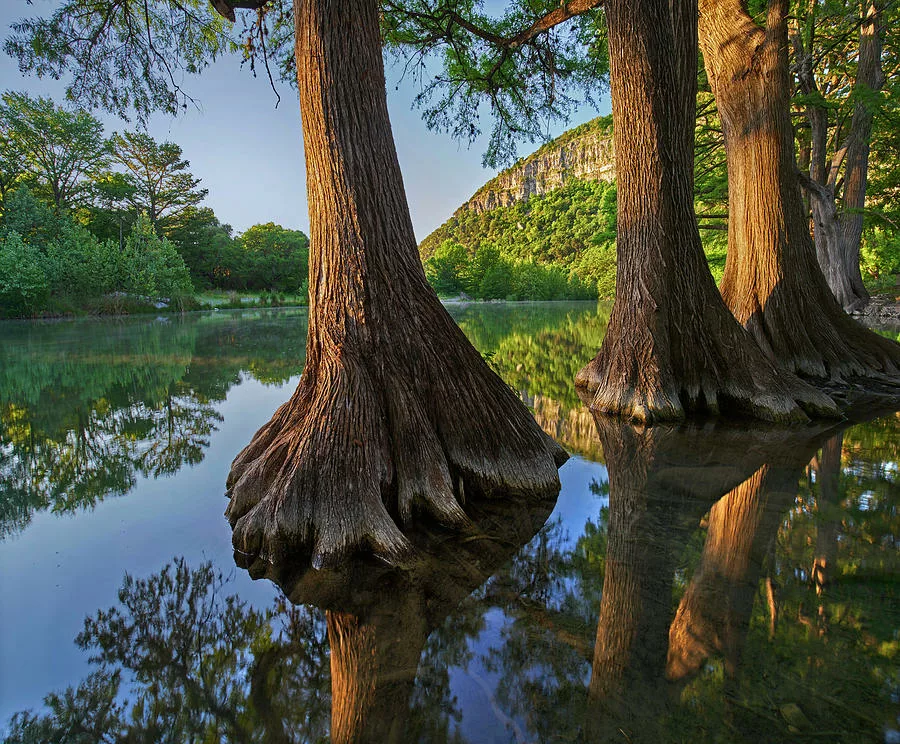
Pro Tips:
- Bring tubes or rent on site
- Be mindful of currents after storms
- Some RV loops have limited shade, so be sure to scope site photos before you book.
- This park hits capacity often from Memorial Day through Labor Day
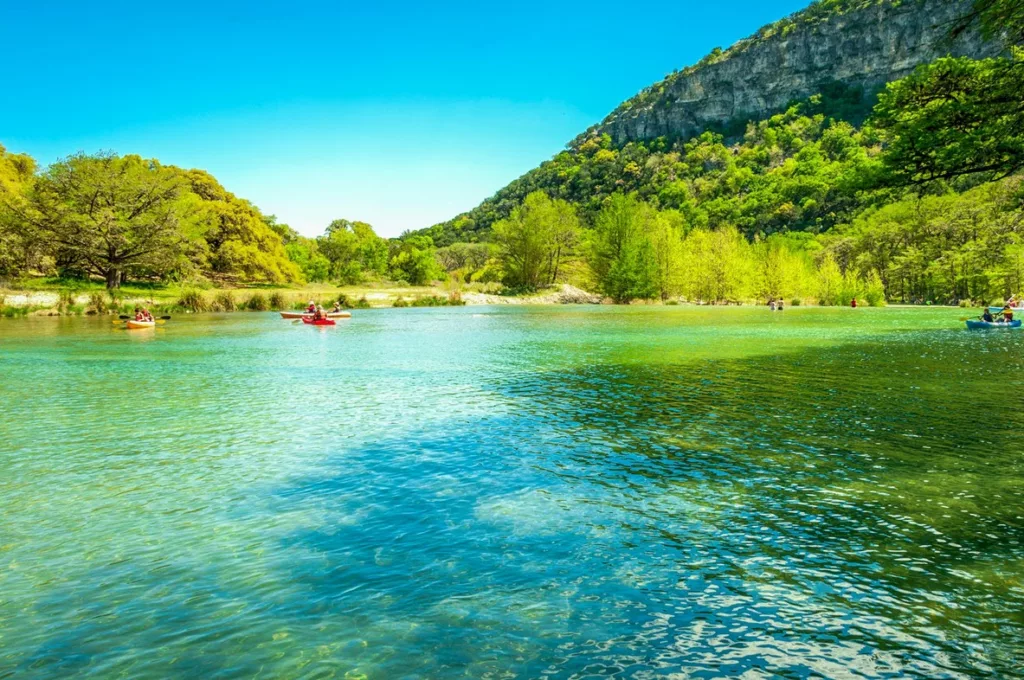
Where to swim & float: Aim for the deep pools near the river dam and concessions area when levels are low; they hold the coldest water. Bring your own tubes or grab tube rentals at the Garner Park Store (they even rent “cooler tubes”).
Shade & campsites: If full hook-ups are a must, note that the Shady Meadows (full-hookup) area is specifically described as having “no shade or tree cover.” If shade matters more than hook-ups, browse site photos in the other loops and look for riverside cottonwoods/cypress.
Swim Smarts
-
River currents change after storms; obey closures and posted warnings.
-
Water shoes = happier feet on slick limestone.
-
No lifeguards, so keep close watch on kids.
Why it beats the heat: Paddle the clear lake or hike over to Devil’s Waterhole and slip into the canyon pools. When Valley Spring Creek is running, small waterfalls make it extra refreshing.

Current Note (summer 2025):
Devil’s Waterhole reopened after July flooding; conditions are back to normal, but rangers still advise general caution for residual debris and water quality after heavy rains.
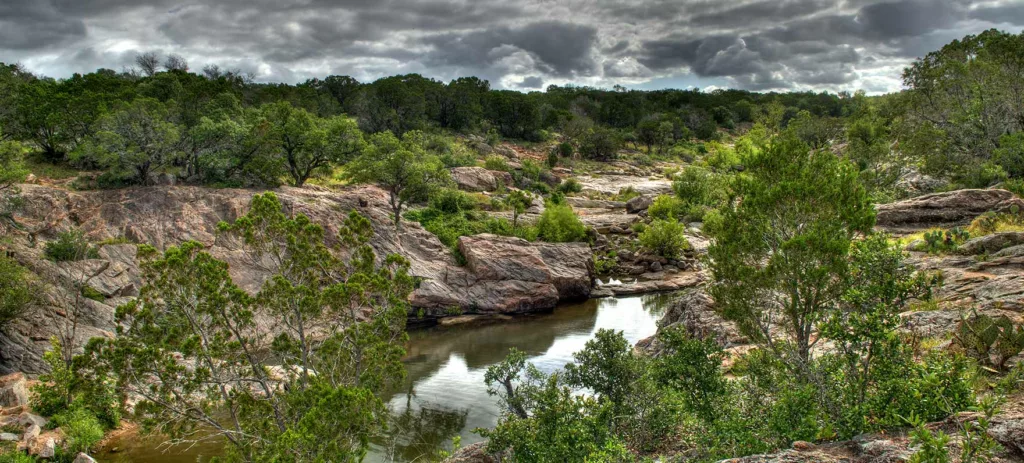
Where to swim & paddle: Swim at Devil’s Waterhole or the main swim areas around the park store. You can rent kayaks, canoes, paddleboats, and SUPs at the store (hourly rates; weather permitting).
Shade & campsites: Lakeside loops have mixed shade; the park offers water-only, water/electric sites, and several mini-cabins (A/C inside) if you want to stay cool between dips. Check the facility map before you book to pick your ideal spot.
Swim Smarts
-
Granite ledges get slick so pack water shoes.
-
Cliff-jumping happens here, but depths vary and it’s at your own risk. Follow signs and use common sense.
Why it beats the heat: Four miles of emerald water slice through the park, with long, shady banks perfect for wading, swimming, and lazy tubing. Off-river, you’ve got oak and pecan groves, short nature trails, and family-friendly bike paths to fill the hours between dips.
Where to swim & float: The main day-use river access areas are perfect for swimming and picnicking; rock bars create easy wade-ins, while deeper pools gather in bends.
If you want a point-to-point float, this section of the Upper Guadalupe doesn’t loop back, so plan a shuttle or use a local outfitter.
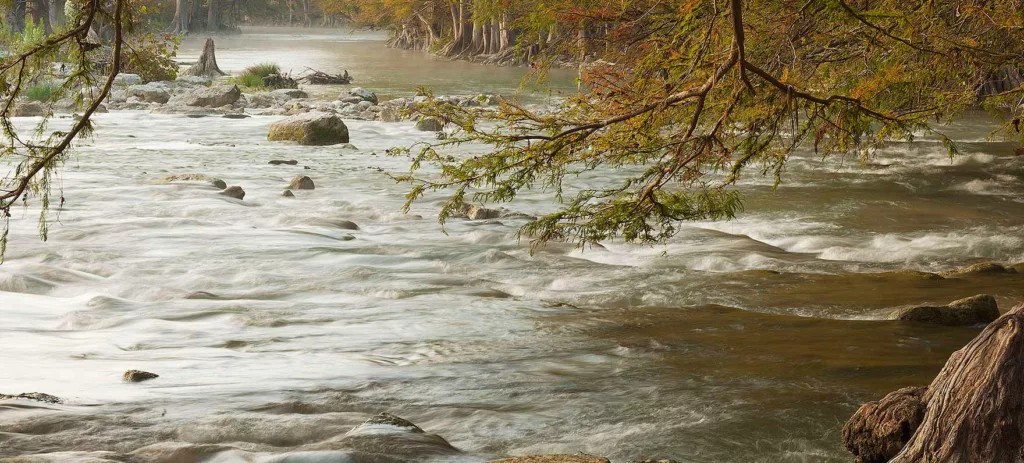
Rentals & Shuttles Nearby:
-
Guadalupe Canoe Livery (Spring Branch) offers kayaks, tubes, rafts, shuttles on Upper Guadalupe segments.
-
Bergheim Campground & River Outfitters (just downriver) has tubes/kayaks/canoes with shuttle service.
Shade & campsites: For a “sleep-cool” setup, consider the Wagon Ford walk-in tent area perched on a terrace above the river (50–100-yard carry; no generators). If you prefer hookups, Cedar Sage has 37 water/electric sites with showers nearby.
Booking & timing tips: This park regularly hits capacity in the summer, so reserve day-use passes and campsites in advance. Gate hours typically 8 a.m.–10 p.m. (double-check before you go).
Swim Smarts
-
River flows change with rain and Canyon Lake releases so obey closures and posted warnings.
-
Limestone = slick; bring water shoes.
-
No lifeguards: keep kids within arm’s reach.
Before you pack the ice, see my tested picks: Best Camping Coolers for Summer Trips
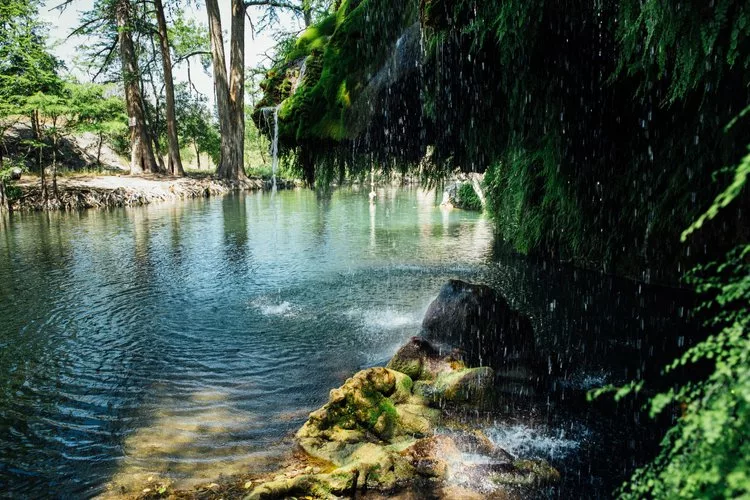
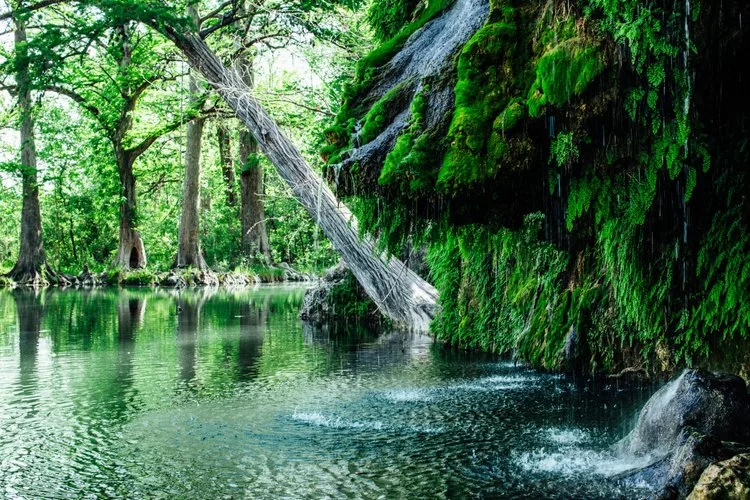
Why it beats the heat: This private Hill Country oasis is fed by 32 springs that hold about 68°F year-round. You get two distinct places to cool off: an upper, spring-fed man-made pool and a lower natural pool beneath a fern-draped waterfall, tucked under deep shade.
The lower pool flows into Little Cypress Creek and on to Lake Travis, so the water keeps moving and stays fresh.
How the swimming works: Stroll down to the lower pool for the “jungle-wall” waterfall vibes and rope-swing energy; head to the upper pool for easier entries and a quick cooldown. Both areas are a short walk from parking, and the grounds have plenty of mature oaks and cypress for midday shade.
Camping & logistics: Tent anywhere in designated primitive areas or book one of 24 RV sites (water/electric); restrooms and spring-water showers on site. Gates close at 8 p.m. (no re-entry after hours).
Good-to-know rules & gear: No pets, no glass, and no tube rentals on site (bring your own floaties; ≤5′ recommended). Water shoes are smart as the limestone is slick. Also, rideshares often won’t pick up from the property; plan your return drive.
Swim Smarts
-
Expect weekend crowds; arrive early for shade and parking.
-
Mind footing on algae-slick rock near the falls.
-
Keep valuables in a dry bag; you will get splashed.
Why it beats the heat: The spring-fed South Llano is slow and family-friendly. Perfect for swimming and short floats between multiple put-in/take-out points.
BONUS: it’s an International Dark Sky Park, so the cool-down continues after sunset with Milky Way views.
Where to swim & float: Multiple put-in / take-out points line the river. The park rents tubes (bring your own kayak/canoe or rent/shuttle locally… Bloody Bucket Kayaks serves this stretch).
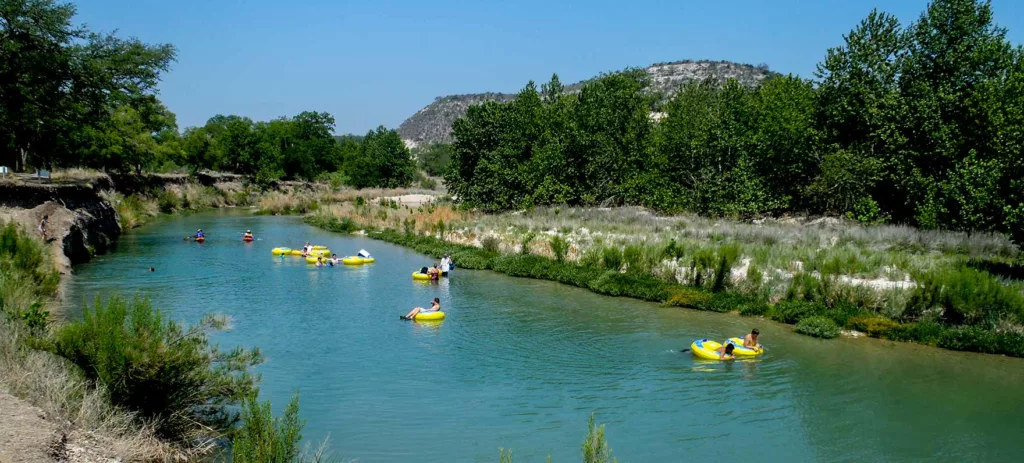
Booking & Timing Tips:
This park often reaches capacity in warm months so reserve day-use passes and campsites ahead of time, and always peek at the park alerts page for current river access notes.

Shade & campsites: Most campsites have water/electric with showers nearby; there are also walk-in tent sites and a handful of primitive hike-ins for extra quiet.
Swim Smarts
-
Limestone can be slick… water shoes help.
-
Watch conditions after heavy rain; flows and access points can change.
-
Swimming is at your own risk in state parks.
Beat the heat safely… steal my best shade, hydration, and cooling hacks in How to Camp in Hot Weather.
Why it beats the heat: A 64-acre spring-fed lake ringed by tall pines = all-day shade and quick, refreshing dips. It’s one of East Texas’ most reliable summer cool-offs.

Pro Tips:
- Arrive before 10 a.m. for easier parking and cooler shade by the swim area.
- When paddling, hug the shoreline for shade and calmer water; keep clear of the fishing pier and boat ramp.
- Bring a hammock with tree-friendly straps; the pines make perfect anchors for midday naps.
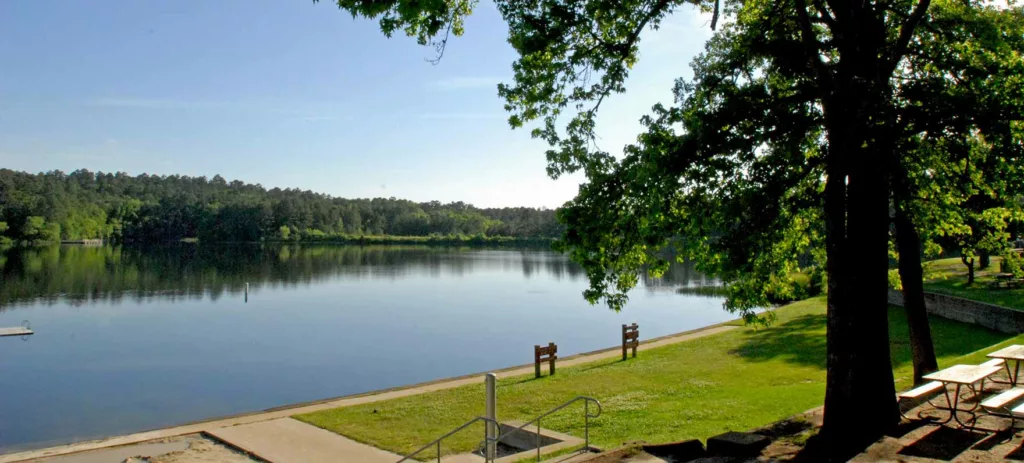
Where to swim & paddle: Head for the designated swim area (with a floating dock) or rent kayaks, canoes, SUPs, paddleboats, and jon boats at the park store. Rentals run most of the year (daily in summer; Thu–Mon the rest of the year).
Shade & campsites: Choose from water-only, water/electric, and full-hookup sites, plus screened shelters and cabins if you want A/C in between swims. Trails and many campsites sit under deep Pineywoods shade.
Swim Smarts
-
Stick to the roped swim area and keep an eye out for boats (lake has a 5 mph speed limit, but stay alert).
-
Life jackets are included with rentals; use them for kids and weak swimmers.
Why it beats the heat: Shade from towering pines and a calm, no-wake lake makes for easy summer relief. Lake Raven (approx 210–215 acres) has a roped designated swim area and an idle-speed rule that keeps water mellow for swimmers and paddlers. Self-service kayak rentals sit right by Raven Lodge.

Pro Tips:
- Wildlife-proof your cooler (raccoons are clever) and store food in your vehicle at night.
- Summer = mosquitoes & chiggers; use repellent, wear light long sleeves, and treat socks with permethrin.
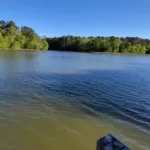
Where to swim & paddle: Cool off at the swim beach (10 a.m.–8 p.m., no lifeguards), then grab a kayak from the self-service rentals near the lodge or launch your own at the ramp (motorboats allowed at idle speed only). Anglers: enjoy Free Fishing in State Parks… no license needed when you fish within park boundaries.
Shade & campsites: Pick your comfort level: full-hookup RV sites (Raven Hill), water/electric loops (Coloneh, Prairie Branch), or water-only sites. Prefer solid walls? The park also has screened shelters (with electric) tucked under the trees near facilities.
Swim Smarts
-
This is gator country so swim only in the designated area and follow TPWD’s alligator safety guidance (avoid dawn/dusk, keep kids close).
-
No lifeguards on duty; life jackets for kids/weak swimmers are a good call.
Why it beats the heat: The spring-fed pools at Spicewood Springs stay refreshingly cool, with small cascades and shaded pockets you can hop between on a short, mostly flat approach. Swimming is also allowed in the Colorado River.

Pro Tips:
After recent flooding in 2025, the park is open for day use and select camping, with several trails/areas still closed; reserve ahead and check alerts the day you go.
Note the automated gate (typically closes 10 p.m.).
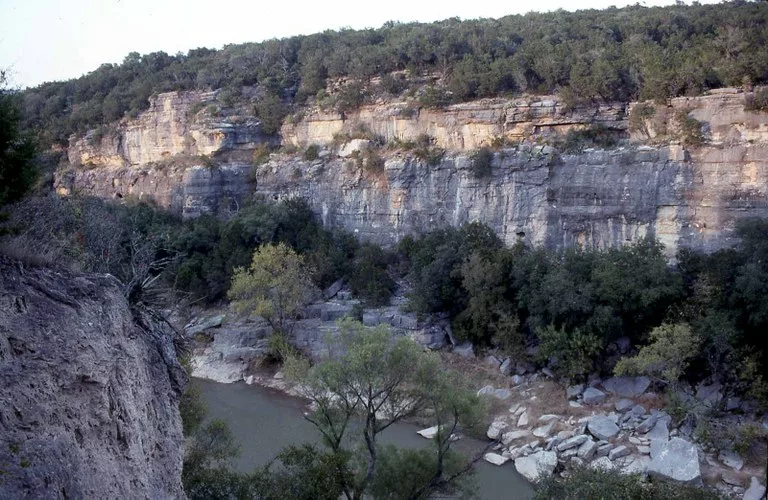
Where to swim & wander: Make a beeline for the first Spicewood pool (easy access), then explore upstream for more pools and mini-waterfalls. Portions of the Spicewood Springs Trail beyond the main swimming area are currently closed due to flood damage; heed signs and stay within open sections.
Shade & campsites: This is back-to-nature camping: drive-up, walk-in, and hike-in sites with water nearby, no hookups, composting toilets, and an open-air rinse-off shower. Some drive-up sites (#35–47) sit 75–100 yards from the river, making them great for quick dips.
Swim Smarts
-
No lifeguards; swim at your own risk and watch footing on algae-slick limestone.
-
Respect trail/area closures and fragile springs (enter only where allowed).
-
If you hike to Gorman Falls, know it’s look-don’t-swim
